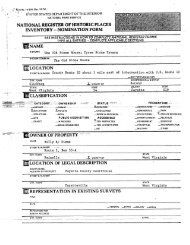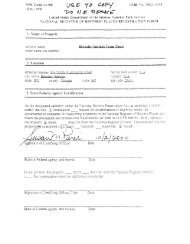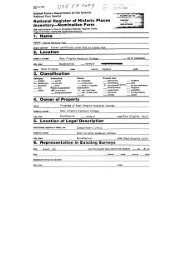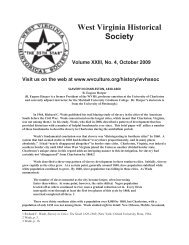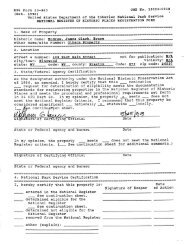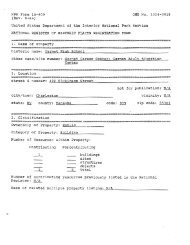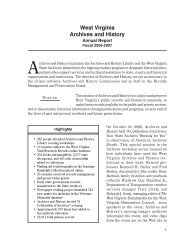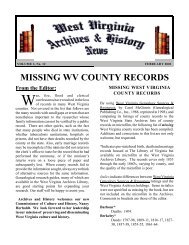Carter Coal Company store - West Virginia Division of Culture and ...
Carter Coal Company store - West Virginia Division of Culture and ...
Carter Coal Company store - West Virginia Division of Culture and ...
You also want an ePaper? Increase the reach of your titles
YUMPU automatically turns print PDFs into web optimized ePapers that Google loves.
......................................... -----------------4. State/Federal Agency Certification........................................- As the designated authority under the National Historic Preservation Act<strong>of</strong> 1986, as amended, I hereby certify that this)C nomination- request for determination <strong>of</strong> eligibilitymeets the documentation st<strong>and</strong>ards for registering properties in theNational Register <strong>of</strong> Historic Places <strong>and</strong> meets the procedural <strong>and</strong>.......................................... -----------------pr<strong>of</strong>essional requirements set forth in 36 CFR Part 60.the propertymeets- does not meetthe National Register Criteria. - See continuation sheet.\In my opinion,Signature <strong>of</strong> certifwfficialate'State or Federal agency <strong>and</strong> bureauIn my opinion, the property- meets- does not meetthe National Register criteria. - See continuation sheet.Signature <strong>of</strong> commenting or other <strong>of</strong>ficialDateState or Federal agency <strong>and</strong> bureauDateentered in the National Register- See continuation sheet.determined eligible for the . -National Register- See continuation sheet.determined not eligible for theNational Registerremoved from the National Registerother (explain):Signature <strong>of</strong> KeeperDate <strong>of</strong> Action
-----------------___-_-__-__-_----_-----------_------------___-___-__-_-_--__------------------------ -----------------6. Function or Use____________-____-_---_------------------_______-__-_-______-----------------------------------------Historic: comrnerce/tradeSub: department <strong>store</strong>cornmerce/tradebusinessqovernmentpost <strong>of</strong>ficeCurrent : qovernmentSub: post <strong>of</strong>ficebusiness<strong>of</strong>fice buildinq____________-______---------------------_-____________-__-___----------------------------------------7. Description_______________-___---_------------------------____________-__-___------------------------------Architectural Classification:late 19th <strong>and</strong> earlv 20th century American movements-----------------Other Description: n/aMaterials: foundation brickro<strong>of</strong> asphaltwalls brick other concretestucco-Describe present <strong>and</strong> historic physical appearance. - x See continuationsheet.Applicable National Register Criteria: A,CCriteria Considerations (Exceptions) : n/aAreas <strong>of</strong> Significance: architecturecommerceindustryPeriod(s) <strong>of</strong> Significance: ca. 1912-1941Significant Dates : 1922Significant Person(s): n/aCultural Affiliation: n/aArchitect/Builder: unknownState significance <strong>of</strong> property, <strong>and</strong> justify criteria,considerations, <strong>and</strong> areas <strong>and</strong> periods <strong>of</strong> significance noted above.- x See continuation sheez.
Previous documentation on file (NPS): n/a- preliminary determination <strong>of</strong> individual listing (36 CFR 67) has beenrequested.- previously listed in the National Register- previously determined eligible by the National Register- designated a National Historic L<strong>and</strong>mark- recorded by Historic American Buildings Survey #- recorded by Historic American Engineering Record #Primary Location <strong>of</strong> Additional Data:- x State historic preservation <strong>of</strong>fice- Other state agency- Federal agency- Local governmentUniversity- x Other -- Specify Repository: Eastern Reqional <strong>Coal</strong> Archives,Bluef ield, WVVerbal Boundary Description: - See continuation sheet.From the intersection <strong>of</strong> county route 2 <strong>and</strong> Snakeroot Branch, theboundary extends 400' southeast, then 200'southwest, 400' northwest, <strong>and</strong>200' northeast forming a rectangle around the <strong>store</strong>.Boundary Justification: - See continuation sheet.The boundary includes all <strong>of</strong> the property historically associated withthe <strong>Carter</strong> <strong>Coal</strong> <strong>Company</strong> <strong>store</strong>. *- Name/Title: Stacv Sone, surveyorOrganization: WV SHPO Date: 12-16-91Street & Number: Cultural Center Telephone: 304-348-0240City or Town: Charleston State:E ZIP: 25305
(NPS Form 10-900)United States Department <strong>of</strong> the InteriorNational Park Service- NATIONAL REGISTER OF HISTORIC PLACESCONTINUATION SHEETaSection number 7 Page 1 <strong>Carter</strong> <strong>Coal</strong> <strong>Company</strong> <strong>store</strong>,<strong>Coal</strong>wood---The <strong>Carter</strong> <strong>Coal</strong> <strong>Company</strong> <strong>store</strong> at <strong>Coal</strong>wood is the only extant company<strong>store</strong> in McDowell County that appears to st<strong>and</strong> as a unit in a row <strong>of</strong>commercial buildings. The building was constructed by the <strong>Carter</strong> <strong>Coal</strong><strong>Company</strong> ca. 1912. In 1922, the Consolidation <strong>Coal</strong> <strong>Company</strong> bought theproperty <strong>and</strong> altered the facade making the <strong>store</strong> section more pronounced.Most <strong>of</strong> building has not been altered substantially since its years underConsolidation <strong>Coal</strong> <strong>Company</strong>'s ownership. It retains its integrity <strong>of</strong>materials, design, workmanship, location, <strong>and</strong> association.The company <strong>store</strong> is a single building that is currently divided int<strong>of</strong>our sections. The ro<strong>of</strong>line is flat <strong>and</strong> even but each section is clearlydefined. The <strong>Coal</strong>wood post <strong>of</strong>fice occupies the first section. This isthe most altered part <strong>of</strong> the building with its new windows <strong>and</strong> doors.The vacant section next to the post <strong>of</strong>fice served as the <strong>store</strong> underConsolidation <strong>Coal</strong> <strong>Company</strong>. The <strong>store</strong> is easily recognizable because <strong>of</strong>its recessed center entrance <strong>and</strong> large display windows. Access to theentrance is up a short flight <strong>of</strong> stairs <strong>and</strong> through new double doors.B<strong>and</strong>s <strong>of</strong> plaster between the windows <strong>and</strong> below the ro<strong>of</strong>line embellish thefacade <strong>and</strong> adds variety to the row's facade.The building's next section has not been altered since its ca. 1912construction date. This eight-bay <strong>of</strong>fice section includes an <strong>of</strong>f-centerdoor <strong>and</strong> double-hung windows. Tall transoms in segmental arched openingssit over each bay. The end section holds six bays that are an additionmade to <strong>Carter</strong>'s original <strong>store</strong> after Consolidation <strong>Coal</strong> took over. Thissection's facade is similar to the original one next to it except for thelack <strong>of</strong> transoms over the windows.Consolidation <strong>Coal</strong> <strong>Company</strong> constructed another building adjacent to theoriginal <strong>store</strong> to house more <strong>of</strong>fices. Although it is a separatebuilding, its facade <strong>and</strong> ro<strong>of</strong>line are even with the earlier building.The windows are double hung <strong>and</strong> the center entrance is recessed. Olga.- <strong>Coal</strong> <strong>Company</strong>'s <strong>of</strong>fices currently occupy this building.The building's appearance changed considerably since its constructiondate. Originally, what is now the first section was identical to thecurrent third section. The middle section held windows that matched theflanking bays <strong>and</strong> the building's main entrance. The facade was perfectlysymmetrical with a center entrance made prominent only by double doors.The facade was not divided into sections but had an unbroken, uniformarrangement. The building contained <strong>of</strong>fices but was mostly <strong>store</strong> space.
(NPS Form 10-900)United States Department <strong>of</strong> the InteriorNational Park ServiceNATIONAL REGISTER OF HISTORIC PLACESCONTINUATION SHEETSection number 7 Page 2 <strong>Carter</strong> <strong>Coal</strong> <strong>Company</strong> <strong>store</strong>,<strong>Coal</strong>wood ---.-- -.- -When Consolidation <strong>Coal</strong> bought the property in 1922, it reduced the size<strong>of</strong> the <strong>store</strong> to accommodate more <strong>of</strong>fice space. It left the <strong>store</strong> in thecenter <strong>of</strong> the building <strong>and</strong> made that section prominent by adding acrenelated parapet, a recessed entrance, display windows, simpledecoration, <strong>and</strong> an awning. The facade on the two outer sections <strong>of</strong> thebuilding remained the same. The company added another <strong>of</strong>fice onto it <strong>and</strong>also a separate building. Each section had its own entrance which madethe single building look like a row <strong>of</strong> five different buildings. Theonly changes that have occurred since Consolidation <strong>Coal</strong>'s ownership arethe new doors in the <strong>store</strong> section <strong>and</strong> the absence <strong>of</strong> its parapet, <strong>and</strong>the recent remodeling <strong>of</strong> the first section which now has new windows.The <strong>store</strong> <strong>and</strong> <strong>of</strong>fice buildings are located in a relatively flat areasurrounded by <strong>Coal</strong>wood1s other important buildings that Consolidation<strong>Coal</strong> <strong>Company</strong> constructed. Across from the brick row is a magnificenttwo-story clubhouse <strong>and</strong> a steepled church. Nearby on a hill st<strong>and</strong>s animposing multigabled supervisor's house. In the same area near the <strong>store</strong>are maintenance shops <strong>and</strong> company-built apartment buildings with halftimberdecoration.Although the <strong>store</strong> building changed since <strong>Carter</strong> <strong>Coal</strong> <strong>Company</strong>'sownership, it remains substantially unaltered since its years underConsolidation <strong>Coal</strong>.
(NPS Form 10-900)United States Department <strong>of</strong> the InteriorNational Park Service- NATIONAL REGISTER OF HISTORIC PLACESCONTINUATION SHEETSection number 8 Page 1 Car ter <strong>Coal</strong> <strong>Company</strong> <strong>store</strong>,<strong>Coal</strong>woodThe <strong>Carter</strong> <strong>Coal</strong> <strong>Company</strong> <strong>store</strong> is eligible for listing on the NationalRegister <strong>of</strong> Historic Places under criterion A for its historicalassociation with southern <strong>West</strong> <strong>Virginia</strong>'s coal mining industry <strong>and</strong> undercriterion C for its architectural significance. <strong>Carter</strong> <strong>Coal</strong> <strong>Company</strong>built the large brick <strong>store</strong> building ca. 1912 <strong>and</strong> during the yearsfollowing, it served as an important commercial, business, <strong>and</strong> socialcenter in the coal mining community. In 1922, Consolidation <strong>Coal</strong> <strong>Company</strong>bought control <strong>of</strong> the mine then altered the <strong>store</strong> to clearly divide itsfunctions (for historical information about the Pocahontas <strong>Coal</strong>field <strong>and</strong>the significance <strong>of</strong> company <strong>store</strong>s, see sections E <strong>and</strong> F in "<strong>Coal</strong> <strong>Company</strong>Stores in McDowell County", multiple property listing). The buildingcurrently st<strong>and</strong>s as part <strong>of</strong> a commercial row as it did under the lattercompany's ownership. It has been well-maintained so that it retains itsearly appearance when it served as a coal company <strong>store</strong>.Before the coal industry boomed in southern <strong>West</strong> <strong>Virginia</strong> at the end <strong>of</strong>- the nineteenth century, the area consisted <strong>of</strong> scattered, self-sufficientfarms <strong>and</strong> communities. Because <strong>of</strong> the absence <strong>of</strong> railroads <strong>and</strong> goodroads, the southern counties had little interaction with the rest <strong>of</strong> thenation. After the Civil War, however, the nation's industrial marketexp<strong>and</strong>ed <strong>and</strong> outsiders began to turn their attention to <strong>West</strong> <strong>Virginia</strong>'svast coal reserve to meet growing dem<strong>and</strong>s.The major railroads extended their lines into southern <strong>West</strong> <strong>Virginia</strong>allowing the area to be developed. Without a sufficient labor force,however, coal mining could not be productive. Companies recruitedthous<strong>and</strong>s <strong>of</strong> workers first from the older coalfields in Pennsylvania, <strong>and</strong>then from Eastern Europe <strong>and</strong> the American South. To accommodate thesenew arrivals, coal companies built self-sufficient communities to house<strong>and</strong> provide for their workers, The construction <strong>of</strong> company towns wasabsolutely necessary in southern <strong>West</strong> <strong>Virginia</strong>. Unlike the northerncoalfields <strong>of</strong> Pennsylvania, where mining operations began in regions thatwere already settled, southern mines opened in sparsely settled areaswith few organized communities. The company town was the most logical -solution because it provided efficient <strong>and</strong> inexpensive housing for alarge labor force.Central to each <strong>of</strong> these communities was the company <strong>store</strong>. The <strong>store</strong>was usually the towns's most prominent building <strong>and</strong> was typically placedin an easily accessible location. The building <strong>of</strong>ten housed not only a<strong>store</strong> but also the company's business <strong>of</strong>fice, a post <strong>of</strong>fice, <strong>and</strong>sometimes, a doctor's <strong>of</strong>fice. Because <strong>of</strong> its location <strong>and</strong> multiple
(NPS Form 10-900)United States Department <strong>of</strong> the InteriorNational Park Service- NATIONAL REGISTER OF HISTORIC PLACESCONTINUATION SHEETSection number 8 Page 2 Car ter <strong>Coal</strong> <strong>Company</strong> <strong>store</strong>,<strong>Coal</strong>woodfunctions, the <strong>store</strong> provided each community with a center for socialgathering.The company <strong>store</strong> first served <strong>Coal</strong>wood residents employed by the <strong>Carter</strong><strong>Coal</strong> <strong>Company</strong>. Just after the turn <strong>of</strong> the century, George L. <strong>Carter</strong>, aniron furnace manager from <strong>Virginia</strong>, acquired rich McDowell County l<strong>and</strong><strong>and</strong> in 1912, organized the <strong>Carter</strong> <strong>Coal</strong> <strong>Company</strong>. He constructed a shaftmine at <strong>Coal</strong>wood <strong>and</strong> at nearby Caretta <strong>and</strong> claimed that his company wouldbe the largest coal producer along the N & W Railroad. The brick company<strong>store</strong> dates to around the time when <strong>Carter</strong> organized the company. Thissingle building served the community as the center <strong>of</strong> commercial,business, <strong>and</strong> social activity in the industrial community. It <strong>of</strong>fered awide variety <strong>of</strong> merch<strong>and</strong>ise in its spacious display area <strong>and</strong> it alsohoused the post <strong>of</strong>fice, <strong>and</strong> the company's payroll <strong>and</strong> accounting <strong>of</strong>fice.Miners <strong>and</strong> their families typically visited the <strong>store</strong> daily to purchasegoods <strong>and</strong> to receive mail <strong>and</strong> then h<strong>and</strong>led other business in the <strong>of</strong>fice- section. Because <strong>of</strong> its convenient location near the residential areas<strong>and</strong> the mine, the building was a constant gathering point.In 1922, <strong>Carter</strong> sold his mines to the New York-based Consolidation <strong>Coal</strong><strong>Company</strong>. The latter company organized these mines into itsPocahontas-New River <strong>Division</strong> <strong>and</strong> based its division headquarters in<strong>Coal</strong>wood. The company invested several million dollars over the nextseveral years <strong>and</strong> substantially exp<strong>and</strong>ed the entire operation. By 1931,the company operated four modern mines but the shaft operations at<strong>Coal</strong>wood <strong>and</strong> nearby Caretta were its leading producers.The company claimed that it developed <strong>Coal</strong>wood into a model communitywith modern houses <strong>and</strong> plenty <strong>of</strong> public facilities. It continued tooperate its <strong>store</strong> in the one story brick building that <strong>Carter</strong> built. Italtered the center <strong>of</strong> the facade making the <strong>store</strong> section more pronouncedthan the adjacent sections. When Consolidation <strong>Coal</strong> completed itsadditions <strong>and</strong> remodeling, the original <strong>store</strong> looked like a commercial rowwith five distinct sections. The <strong>Coal</strong>wood <strong>store</strong> is the only extant <strong>store</strong>in McDowell County that st<strong>and</strong>s in this arrangement.Consolidation <strong>Coal</strong> <strong>Company</strong> only operated the mines until 1933. Theoriginal owner, George <strong>Carter</strong>, negotiated with Consolidation <strong>Coal</strong> <strong>and</strong>bought back the <strong>Coal</strong>wood <strong>and</strong> Caretta facilities. <strong>Carter</strong> reorganized<strong>Carter</strong> <strong>Coal</strong> <strong>Company</strong> with his son as president. In 1948, <strong>Carter</strong> sold thecompany to Youngstown Sheet <strong>and</strong> Tube <strong>Company</strong> which bought the mines to
(NPS Form 10-900)United States Department <strong>of</strong> the InteriorNational Park Service- NATIONAL REGISTER OF HISTORIC PLACESCONTINUATION SHEETSection number 8 Page 3 Car ter <strong>Coal</strong> <strong>Company</strong> <strong>store</strong>,<strong>Coal</strong>woodsupply their steel mills in Ohio. It operated the mines under the nameOlga <strong>Coal</strong> <strong>Company</strong> <strong>and</strong> it continues to own the business buildings in bothcommunities.The <strong>store</strong>'s importance in the community decreased as automobiles <strong>and</strong> goodroads allowed miners access to other commercial centers. The <strong>store</strong>closed before mining ceased in <strong>Coal</strong>wood leaving the building vacantexcept for the post <strong>of</strong>fice in one section. Unlike so many <strong>store</strong>s thatwere simply ab<strong>and</strong>oned, the <strong>Carter</strong> <strong>Coal</strong> <strong>Company</strong> <strong>store</strong> has been maintained,retains its original fabric, <strong>and</strong> is structurally sound. The <strong>store</strong> isless ornate than some <strong>of</strong> those that followed but it remains a goodexample <strong>of</strong> an early brick <strong>store</strong> <strong>and</strong> how it changed to suit anothercompany's needs.
(NPS Form 10-900)United States Department <strong>of</strong> the InteriorNational Park .Service- NATIONAL REGISTER OF HISTORIC PLACESCONTINUATION SHEETSection number 9 Page 1 <strong>Carter</strong> <strong>Coal</strong> <strong>Company</strong> <strong>store</strong>, <strong>Coal</strong>woodCarroll County Historical Society, Hillsville, Va. "George L. <strong>Carter</strong> -Capitalist". unpublished information on file, Eastern Regional <strong>Coal</strong>Archives, Bluefield, WV.<strong>Coal</strong>wood/Caretta, file, Eastern Regional <strong>Coal</strong> Archives, Bluefield, WV.<strong>Coal</strong>wood, photograph file, Eastern Regional <strong>Coal</strong> Archives, Bluefield,wv ."<strong>Coal</strong>wood: <strong>Carter</strong>'s Legacy". Bluefield Daily Teleqraph (Dec. 31, 1989).<strong>Company</strong> Stores, file, Eastern Regional <strong>Coal</strong> Archives, Bluefield, W.Conley, Phil, ed. "The Consolidation <strong>Coal</strong> <strong>Company</strong>--An Industrial Giant".The <strong>West</strong> Virsinia Review 9(Oct. 1931), 74-76.-Eller, Ronald D. Miners, Millh<strong>and</strong>s, <strong>and</strong> Mountaineers. Industrialization<strong>of</strong> the Appalachian South, 1880-1930. Knoxville, TN: University <strong>of</strong>Tennessee Press, 1982."New Shaft Mine To Be Big Producer". Bluefield Dailv Teleqra~h (March 22,1914).
&- -.-QUACRANGLE LOCATIONROAD CLASSIFICATIONF os59Primary highway, all weather L~ght-duty road, all weather, *,*+hard surface improved surface %Secondary highway, all weather, Unimproved road, fair or dryhard surface ------. weather =========0 U. S Route 0 State RouteDAVY, W. VA.NW/4 WELCH 15' QUADRANGLEN3722.5-W8137.5l7.51968AMS 4658 I NW-SERIES V854





